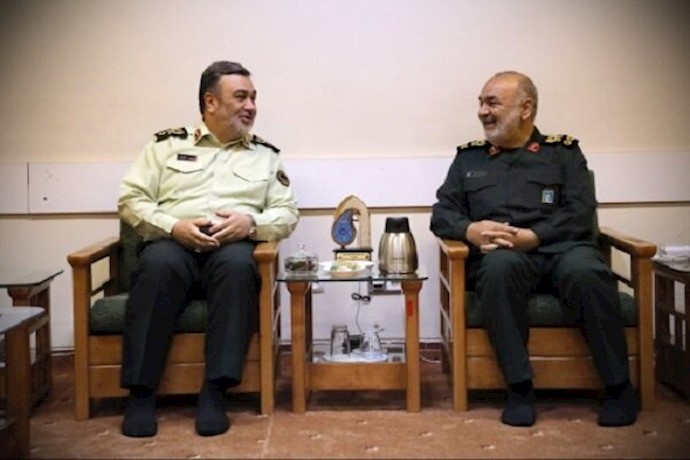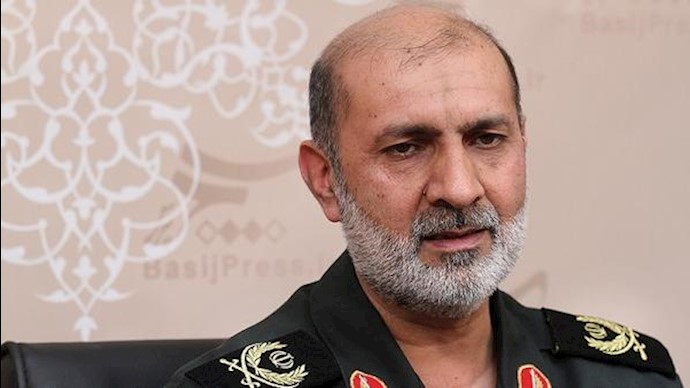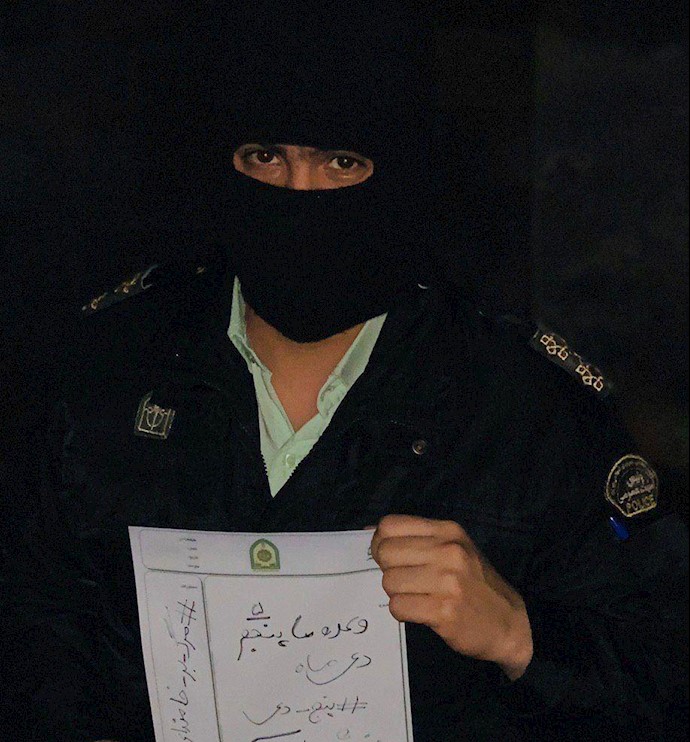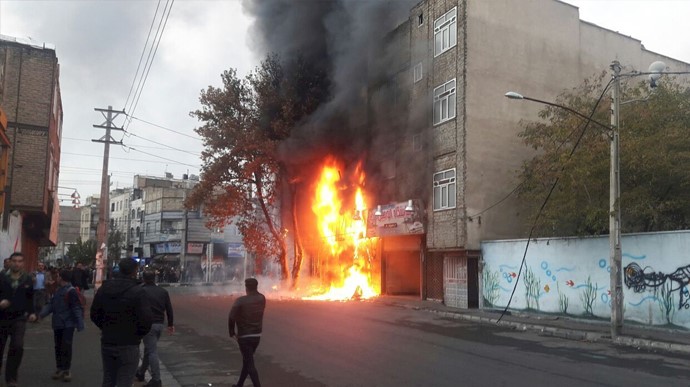Analysis by PMOI/MEK
Iran, December 29, 2019—By the end of the day on November 14, the Iranian regime’s TV shocked the Iranian people by tripling the price of gasoline without any prior warnings. The gas price hike was being discussed between regime officials on many occasions and the news was first leaked on May 2, 2019. But the regime decided not to change the price in fear of the Iranian people’s reaction and the possibility of new protests—90 percent of the Iranian people are under the poverty line and the gas price hike deteriorates the lives of many Iranians.
In November, the regime tried to compensate its budget by increasing the gas price hike. The regime was confident that the people will certainly react against the gas price hike. Authorities placed security forces and anti-riot units on high alert. The regime even stationed a police car in every gas station. “The Police disagreed with the government on the gas price hike and the timing and we believed that it should be reviewed again. However, we said we are ready if this decision is adopted… Police units were stationed in gas stations on Thursday night (November 14),” said Iranian regime police chief Hossein Ashtari.

Iranian regime police chief Hossein Ashtari (left) along with IRGC commander in chief Hossein Salami (right)
But there were two factors ignored by the regime that caught the entire regime off guard: The amount of people’s anger and the oppressive forces’ incapability.
The people
The first factor that the regime did not count on was the amount of Iranian people’s anger and hate for the regime.
The regime has an assessment from the people’s protests. As experienced in the January 2018 uprising, the regime’s assessment concluded that people would pour into the streets for a couple of days and the regime will manage to control the crowd.
In fact, during the 2009 and 2018 uprisings, the regime’s strategy focused on refraining from public bloodshed in the streets, knowing such an outcome in the streets will expedite the regime’s end. Therefore, in 2009 and 2018 the regime attempted to arrest the leaders and active protesters through night raids on their houses and secretly killing many protesters in detention under the pretext of “suicide” etc… The Kahrizak Detention Center, an underground compound where the regime claimed many protesters committed suicide, was trending the Iranian people after the 2009 uprising.
The regime also assessed that crowds in different cities would gather in sites traditionally used for protests. This includes Enghelab Street in front of Tehran University and other such areas in the Iranian capital. As a result, the security forces would be able to easily handle the situation and crush the demonstrations even if the protesters set some police cars or trash bins on fire.
The reality, however, came as a terrible blow to the regime. This time around the rebellious people who were fed up with the entire regime poured into streets of over 191 cities in an organized manner. A few hours after the protests, organized crowds chanted slogans against the regime’s supreme leader Ali Khamenei and his president Hassan Rouhani.
Protesters were demanding regime change and the end of 40 years of dictatorship. Unlike previous uprisings, angry protesters attacked the regime’s key centers, such as governorates, the regime’s seminaries, and state-run banks as centers of corruption and plundering. Protesters also attacked sites of the regime’s oppressive forces, such as police and Revolutionary Guards (IRGC) Basij stations, in a bid to defend themselves from direct fire and a brutal slaughtering carried out by the regime’s forces. Over 1,500 protesters were killed during the protests, according to PMOI/MEK sources inside Iran.
Another key element was that the protesters almost abandoned traditional methods of protest in large numbers in few places. In parallel to the PMOI/MEK strategy (building up rebellious units, districts and towns) protesters established numerous rebellious districts, blocked roads and streets and attempted to liberate their districts from the regime’s forces. In some cases, like Sadra, Eslamshahr, and Shiraz, people could manage to free their cities and towns from the regime forces for almost one or two days.
A PMOI/MEK source reported that in the IRGC “Mohammad Rasoulalah” unit, in charge of for Tehran’s security/suppression, dispatched 400 forces to control four key points of Enghelab district. Yet instead of gathering in one place, protesters spread in many streets in smaller groups. As a result, IRGC forces had to divide their forces into sixteen groups of 25 which did not dare to attack people who were more than them.
In the meantime, reports from inside Iran indicate that PMOI/MEK Resistance Units played a significant role in organizing the protesters.
Regime forces’ incapability
As was told earlier, the regime lost control of many cities and districts, and protesters pushed the regime to the brink of collapse.
In a session with security and government officials, Khamenei issued orders to save the regime from its downfall and do whatever it takes to end the protests. Additionally, in important remarks on November 17, Khamenei backed the gas price hike, described the protesters as “thugs” and ordered security forces to implement their duty.
The regime used many different forces to suppress protesters. The first layer were local police units and their various branches; second were the IRGC paramilitary forces (Basij); and the last layer were the IRGC military forces. The regime thought its forces can easily overcome the protests.
But the inexact assessments from its forces dealt the second blow to the entire regime.
According to PMOI/MEK sources, in many cases, the police did not obey orders to directly shoot the protesters. Regime officials returned many police forces back to protect their bases and armories. A PMOI/MEK source in Behbahan also reported that the commander of local security forces revealed that local police refusing orders were put aside and authorities dispatched Basij forces. They also refused to shoot at the civilians because people could later identify them. Even local IRGC forces refused to shoot and the regime had no choice other than dispatching IRGC Marines from the city of Ahvaz to open fire on protesters.
In today’s world, social media is a place where people are revealing names and addresses of oppressive forces who took part in the November bloodshed. These measures that generated fear among the regime’s suppressive forces, and God knows what will happen in the future. The minimum price for them is losing reputation everywhere they are identified.

Iranians posting the identity and images of the regime’s security forces who opened fire on protesters during the November uprising
Another PMOI/MEK source reported that a high-ranking security force commander said that there are 1,200 security forces in custody due to disobeying orders.
PMOI/MEK sources also revealed that the regime’s Majlis (parliamentary) National Security and Foreign Policy Committee discussed the dilemma of not knowing what to do with 500 armed personnel who did not shoot protesters; if they impose harsh penalties, it will have some consequences and if they don’t, it will result in other consequences.
These facts can shed light on the regime officials’ statements. In her interview, Leila Vatheghi, the regime’s governor in Qods City near the capital Tehran talked about disarray among the security forces on November 16. She openly talked about unknown reasons why security forces disappeared and fled the scene.
Other reports received by PMOI/MEK from inside the regime clarify more about the disarray among the regime’s armed forces. A security forces commander in one of Tehran’s districts reported to his superior that if a regime official wanted to visit and deliver a speech in his unit, he could gather over 470 personnel before 2018; after the 2018 uprising the number reduced to 180, and now even if a general came to deliver a speech, they could just gather 50 personnel!
Currently, the regime’s low-ranking armed forces are realizing that the regime is increasing the armed forces’ budget every year and their high-ranking commanders’ wealth is skyrocketing. All the while, their living conditions are deteriorating and have no share in the regime’s plunders and corruption.
The downfall of the regime’s forces is now the matter of discussion among high-ranking officials. According to PMOI/MEK sources, in a private meeting with IRGC and Basij officials, IRGC General Rasoul Sanaee Rad, an official close to Khamenei, said that one of the regime’s fundamental problems is the lack of public confidence. He also said those forces with us yesterday are not with us today… Sanaee Rad stated that their forces neither believe in their commanders nor have the least necessities of their livelihoods. He also revealed that the regime’s forces bickered about why Khamenei did not reduce the gas price if it was Rouhani’s fault? Why did Khamenei support the gas price hike and why was this issue not discussed through legal ways in the parliament? Sanaee Rad warned the regime officials that this is a growing phenomenon that must be managed before it deteriorates.

IRGC General Rasoul Sanaee Rad
Now the situation has significantly deteriorated for the regime. The noose of poverty is tightening daily around people’s necks. Inflation is increasing day after day. The regime cannot manage the status quo and has no initiative to do so as it continues to plunder and embezzle to empty the Iranian people’s pocket. Over 90 percent of Iran’s society is in poverty and meanwhile, lack of freedom is added insult to injury. Talking to many Iranians, they say they have nothing to lose anymore.
Moreover, the regime’s suppressive forces are increasingly disobeying orders and even in some cases declared that they will join the protesters in the next uprisings.
The question is can the regime continue kicking the can down the road?

An Iranian regime security officer holds a paper reading, “Death to Khamenei”





